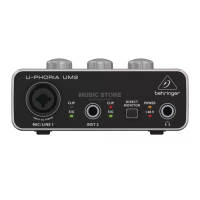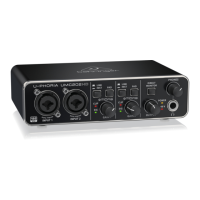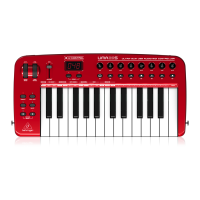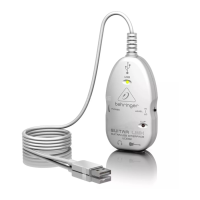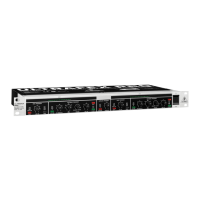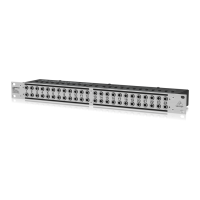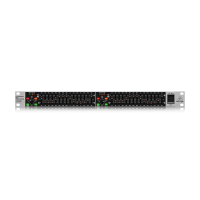(1) INPUTS accept XLR or ¼ " connections from
microphones, instruments, or line level
audio sources.
(2) P+48V switches turn on +48 Volt
Phantom Power to XLR inputs 1 to 4,
and 5 to 8. Carefully read your microphone’s
documentation before turning on phantom
power, as it can damage some microphones.
(3) LINE / INST selects line level or instrument
level input source at the ¼ " connector.
Select INST when connecting a guitar directly.
(4) PAD reduces the level of input signals from the
XLR and ¼ " inputs. For example, this is useful
if the XLR input is not from a microphone.
(5) SIG LED indicates an audio signal is present.
The CLIP LED turns on if the audio input signal
is too high.
(6) GAIN knob adjusts the input level. Adjust so
the CLIP LED does not turn on, even during
the highest peaks.
(7) IN 1-2 or 1-8 selects direct analog input
sources 1-2 or 1-8 for monitoring.
(8) STEREO/MONO selects stereo or
mono monitoring.
(9) MONITORING knob adjusts the mix between
the direct inputs and computer playback:
IN: only direct inputs (0 ms latency)
MIX: 50/50 mix of inputs and playback
from computer
PB 1-2: only playback from computer
(10) DIM switch reduces the MAIN OUT output level.
(11) MUTE switch cuts the MAIN OUT signal.
(12) MAIN OUT knob controls the
MAIN OUT output level.
(13) OPT I/O selects the operation of the rear panel
optical and coaxial RCA I/O ports:
SPDIF: Optical input S/PDIF 9-10,
Optical output S/PDIF 11-12. Coaxial input o ,
Coaxial output S/PDIF 11-12.
ADAT:
(@ 96 or 88.2 kHz) Optical input S/MUX 11-14,
optical output S/MUX 13-16. Coaxial input
S/PDIF 9-10, Coaxial output S/PDIF 11-12.
(@ 48 or 44.1 kHz) Optical input ADAT 11-18,
optical output ADAT 13-20. Coaxial input
S/PDIF 9-10, Coaxial output S/PDIF 11-12.
Caution: Do not change between S/PDIF
and ADAT modes while operating your DAW
/ music program, because the UMC1820
does a quick re-boot. Close all applications
before changing modes, and then wait until
the unit has been recognized again by your
operating system before restarting your
music application.
(14) PHONES
source selector switch:
1-2: Listen to the stereo MIX signal channels
1-2 from the monitoring section.
3-4: Listen to the playback signal from
computer output channels 3-4.
(15) PHONES level adjustment. Start at minimum
and then turn up to a comfortable and safe
listening level.
(16) PHONES ¼ " TRS stereo headphone outputs.
(17) MIDI I/O LEDs indicates MIDI activity.
(18) POWER LED is on if the power switch is
pressed in and the unit is powered via the
supplied power adaptor.
+48V LED is on if either phantom power
switch (1-4 / 5-8) is on.
(19) POWER switch. Press in to turn on the unit.
The POWER LED will turn on.
Rear Panel
(20) POWER IN connect to the supplied power
adaptor only. Connect the power adaptor to
an AC mains supply that is properly con gured
for the unit. A cable holder above the input
prevents the power connection from being
accidentally pulled out.
(21) USB type B connector. Connect to a computer
USB port with the supplied USB cable.
(22) MIDI IN/OUT connect to external MIDI
controllers and modules.
(23) ADAT or S/PDIF Optical I/O ports support
S/PDIF, ADAT, S/MUX. Input channels are
11 to 18, outputs are 13 to 20. The front panel
OPT I/O-switch (13) selects the operation of
these ports.
(24) S/PDIF I/O ports: RCA coaxial S/PDIF inputs
come in from external sources as input
channels 9 to 10. S/PDIF output channels are
11 and 12.
(25) LINE OUT 3-10 balanced ¼ " TRS outputs
for additional monitoring and recording.
The output signals come directly from the
computer after being converted to analog
by the UMC1820. The output levels are only
controlled by the DAW.
(26) MAIN OUT balanced ¼ " TRS outputs connect
to powered studio monitors for playback and
mixing. Adjust the source using the front panel
MONITORING controls, and adjust the level
using the front panel MAIN OUT controls.

